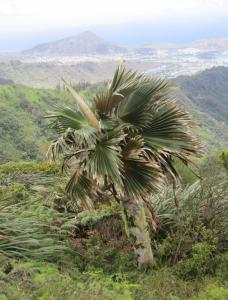 Two Neophloga stand among the red Ti-leaves
Two Neophloga stand among the red Ti-leaves
The Garden at Wakiu is an ever evolving living work of art. We moved to the Garden in 1999, into a new home we built here. The house sits on the site of what was our vegetable garden, we grew a variety of vegetables and a couple rows of Tahitian taro. The fence on the backside of the garden was covered with the vines of the soft shell passion fruit and the lower end was curtained by a stand of purple sugar cane.
The garden was filled mostly with patches of apple bananas and scattered around the perimeter were citrus trees; lemon, grapefruit, and lime to begin with. Also among the citrus were a few macadamia nut trees and some young ulu (breadfruit).
Access to the garden was by way of an unimproved road (grassy and sometimes muddy) down the center lengthwise of the property coming right of the highway. A swinging farm gate was hung on a solid six by six post at the bottom of the first slope about twenty feet from the highway. The sloping entryway leading to the gate was lined on both sides with yucca plants. After the gate, the land leveled out for forty or more feet with a slight slope from left to right as you entered. We planted a Ti-leaf hedge backed by a Wili wili hedge the width of the property at the edge of the level ground before the land took on a second slope for about twenty feet till the next leveling out. From this point on the land has a gradual slope running the rest of the length of the property to the back boundary some seven hundred plus feet from the highway.
The roadway ran halfway down the middle of the land to the end of the cleared area. A bulldozer had been hired to grub the upper half of the property in 1990, before we started to plant; the lower half was still wild with overgrowth. The first of the palm collection was planted lining both sides of the roadway twenty feet apart. These first palms in the garden were Pritchardias that were germinated from seeds collected in the 80s; several of the seeds came from the former Maui Zoo grounds in Kahului where a native Hawaiian garden was planted by Rene Silva, the grounds keeper at the time. Rene gave told me which species of Pritchardia each of the trees were; I had at least one of each of the represented species growing along the roadway. However, over the next ten or so years, I saw one by one of these palms die off mostly from the virus that attacks the growing point of palms. One or two died from boring beetles or worms. Out of the dozen or so Pritchardias that were originally planted, one survives today. It is a Pritchardia munroi, which is among the rarest of the Hawaiian Pritchardias or loulu (as they are called by the Hawaiians).
After we moved into our new home in the garden in 1999, I began to plant more loulu. My goal is to have at least one specimen of each of the species of loulu growing in the garden. It was at this point that the garden started to take form as a repository of native palms. Now that the surviving Pritchardia munroi was about ten years old and bearing fruit (seeds), I found that there was a demand for the seeds in the global palm collecting community. I started looking at palms other than loulu at this time and found that I could trade my loulu seeds with a palm seed merchant for seeds of other palms from all over the world. So, I started germinating these new seeds and planting the palms in the garden; there were more seedlings than I cared to plant in the garden most times, so now I started to wholesale them as potted palms to an outlet in Central Maui. The sales helped to defray the cost of raising these palms, buying plastic pots, potting soil, organic compost and fertilizers. Each time I was ready to make a seed trade, I would ask for the seed merchant’s price list, match up the available seeds with photographs of the mature palms in palm books or on the internet, select the palms that I found to my liking and then traded for the appropriate seeds.
Not all of my seed selections made it to plantable palms; some did not germinate, some germinated but did not survive the early seedling stage, but many did survive and have been planted in the garden or are still potted and waiting for their turn to be planted in the garden. At this point, there are over one hundred fifty species of palms from a good number of genuses that are represented in the garden at Wakiu.























